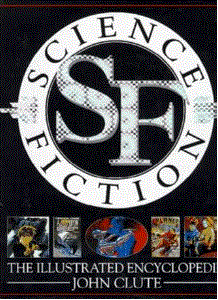One of the things that I love about sci-fi is that inspiration for adventures, aliens, cultures, worlds, and tech can come from just about anywhere. With a little bit of thought, just about anything can be plausibly added to a sci-fi setting. The limits are whatever you decide to place upon yourself. Here is a sampling of some of the non-RPG and non-TV/Movie/Video Game sources I've been using to get ideas for my admittedly kitchen sink setting.
The Visual Encyclopedia of Science Fiction by Brian Ash
This tome, copy-write 1977, is a bit out of date, but it does an excellent job of detailing various aspects of the science fiction genre of the time through the eyes of some of the greats writers and directors in science fiction history. It discusses tech, themes of religion, mutation, the blurring of the line between man and machine, and even sex and cultural taboos. I've found it to be an excellent resource, especially if you're looking for something with a bit more of a "classic" feel to it.
Aliens, Robots, and Spaceships by Jeff Rovin
This book, collected and compiled by Jeff Rovin who has put out several books of this kind in the genres of classic monsters and for Super Heroes and Villains, does a great job of cataloging and detailing, well, aliens, robots, and spaceships from literature, movies, television, comics, and even folklore and mythology. The entries are straightforward, and many have illustrations.
Aliens in Space by Steven Caldwell
Part of Caldwell's "Galactic Encounters" series, this book takes pieces of sci-fi art and binds them together into essentially a sci-fi setting detailing the creatures found to inhabit several worlds in the galaxy. The writing is good, but always feel like a great fit for the art selected. This is the only part of the Galactic Encounters series that I own, but I plan to find copies of the others in the future.
Galactic Aliens by Alan Frank
This book is presented as a catalog of dangerous creatures found throughout man's exploration of the galaxy. The art isn't as good as many of the other books in the list, and the creatures are at time rather simplistic, but there are some interesting creatures to be found. I rather liked the Gorgons, Interstellar Vampires, and the Starbirds.
The Alien World by Steven Eisler
This is a book that's very similar to Caldwell's "Aliens in Space" as it's an art book that ties the pieces together with a backstory of a catalog of aliens of the galaxy. Some of the same pieces used in this book are also used in Caldwell's, but each author's story tied to the art is different (even then there are only a few duplicate pieces). If you like more stranger imagery in your sci-fi, this is a good book to go to and some of the art is pretty surreal, but Eisler does a good job of sort of bringing it down to Earth.
Science Fiction: The Illustrated Encyclopedia by John Clute
Similar in scope to the first book on the list, this book is much more thoroughly illustrated. Published by DK, it's a bit light on information (when compared to Brian Ash's tome), but it is a beauty to page through and with it being published in 1995 covers more modern instances of science fiction media.
Barlowe's Guide to Extraterrestrials by Wayne Barlowe, Ian Summers, and Beth Meacham
This is my favorite book on the list. While not brimming with information, in fact many of the entries are very sparse, it does cover aliens from the books of a number of authors from James White, F.M. Busby, Jack Vance, Isaac Asimov, Larry Niven and others. Barlowe's interpretations of these often times classic examples of aliens in the literature are well researched and also very well done.







No comments:
Post a Comment
Thank you for taking the time to comment.